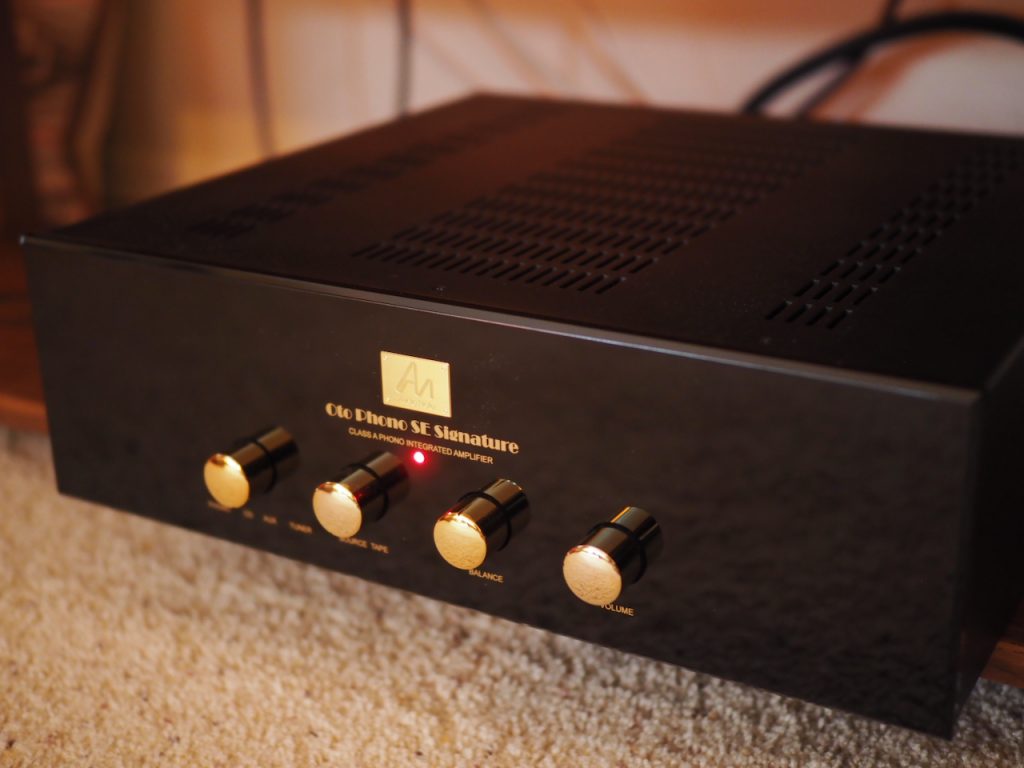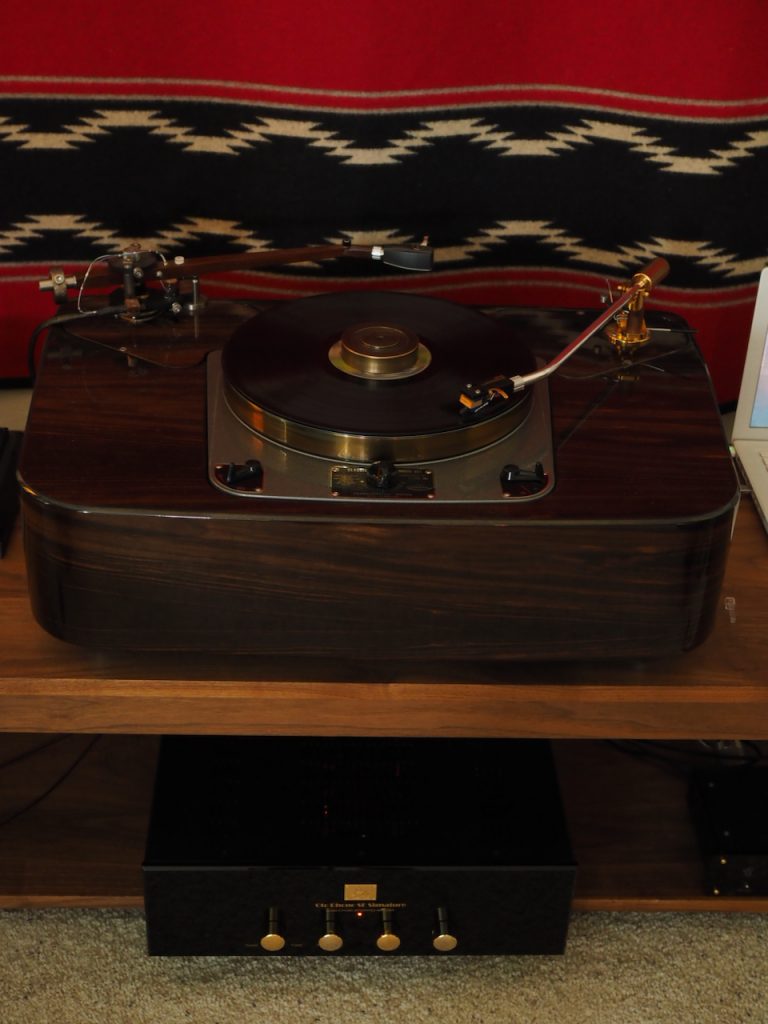As I was casually listening to Jazz24 while doing a few things around the house, I was rather struck by how musical the Audio Note UK Oto Phono SE Signature integrated amplifier was sounding through its "CD" line input, how it always seemed to tug at my attention and pull me into the music regardless of the relatively low volume level I had it set at.
I finally abandoned doing things around the house, succumbed to the music's siren call, and sat down to do some listening just for the sheer pleasure of it.
Other than just enjoying the Jazz24 stream, my impressions were that the Audio Note UK Oto Phono SE Signature integrated amplifier's line stage performance had really "developed" in just the couple of days since my Part 1 report.
Wine aficionados know that you should let a bottle of wine "breathe" for a little while after opening it to let its flavors develop and to release the aromas, and I find that the same sort of approach applies when you place an audio component - even a well run-in one - into a new system context.

It can take a while for an audio component to settle down into a hifi system and equilibrate with it.
Usually when switching components - although not always - my observation is that it takes a few days for everything to settle-in and equilibrate, and the difference in overall performance can be significant, as I was hearing with the Oto Phono SE Signature integrated amplifier.
I'm not exactly sure what the causal factors are behind this "settling-in" phenomena. It may be as simple as the need for a system's cables to settle back down after being disconnected and reconnected, or it might be some sort of system-wide inductance-effect equilibrium that is taking place. I don't know.
What I can tell you for sure is the "settling-in" phenomena can conflict with the desire do quick A-B comparisons, and it means that one probably isn't hearing a component at its best when doing a quickie listening comparison just after installing a new component.
I find that I need to give myself - or more properly, the audio component and hifi system - more time to equilibrate, and to not be in too big a rush, if I really want to get the true measure of a component's performance in my hifi systems.
Back to the Oto Phono SE Signature integrated amplifier.
Wow, what a nice development in the overall performance I was hearing after just a few more days of settling into the system, both from a musicality and visuospatial performance perspective.
The presentation of the music from Jazz24 had "softened" a little, taking a on a more liquid and natural overall "feel".
The musical "flavors" had developed, still with all the exciting presence and clarity the Oto Phono SE Signature displayed earlier, but now the timbral textures had caught up and developed in richness and natural sounding definition in a way that I found really satisfying.
Also, everything had "opened-up" quite a lot, and the sense of spaciousness of a recording venue was revealed to a greater extent, and the soundstage was noticeably more expansive. Particularly, the depth back into the soundstage had become noticeably more layered sounding, with the instruments existing vividly in their space back into the soundstage.
However, my Part 2 report of preliminary listening impressions was supposed to be about using vinyl as the source, to get a handle on phono stage performance, but I wanted to digress for a moment to mention how nicely the Oto Phono SE Signature integrated amplifier was performing after letting it settle-in for a couple of more days.

Now back on topic. I was in a rock & roll mood at that moment, so I listened to a Steely Dan Pretzel Logic LP, followed by the Rolling Stones' Hot Rocks 1964-1971 LPs.
I'll tell you what, the Oto Phono SE Signature integrated amplifier - and its phono stage - really excelled at the motional elements of musicality, giving a very convincing portrayal of beat, rhythm, tempo, and melodies.
This aspect of performance is really important for rock & roll because of it's accentuated backbeat, and the Oto Phono SE Signature integrated amplifier was superb for making rock & roll albums come to life in all their excitement and glory.
Andy Grove, who designed the Oto Phono SE Signature integrated amplifier for Audio Note UK, was telling me in an email he has a number of observations about what design elements allows an audio component to display this sort of live-like musicality in a home listening environment, and I'm really looking forward to hearing more from Andy on this topic.
I want to offer up a few observations of my own for consideration about what makes for engaging home listening.
I find that an audio component - or hifi system - that offers natural sounding overall tone, a realistic rendering of the dynamic spectrum contrasts from soft to loud, gives the impression of a strong sense of "presence" of the musicians in your home listening room, and can play comfortably at live-like SPLs, will be more engaging than an audio component or hifi system that does not excel in those performance elements to the same degree.
The Oto Phono SE Signature integrated amplifier provides those elements of tone, dynamics, presence, and the ability to play at live-like levels, in abundance, and as a result it is very engaging to listen to music with.
For the rock & roll albums I had just listened to, the Oto Phono SE Signature integrated amplifier's ability to provide a strong sense of the accentuated backbeat is key, given an accentuated backbeat is rock & roll's calling card.
There's a number of things that aid the Oto Phono SE Signature integrated amplifier's performance on rock & roll albums, the first of which is its dynamic prowess which makes the beat feel very "live" and engaging.
Surprisingly, the Oto Phono SE Signature integrated amplifier's dynamic prowess is pretty much on par with the solid-state Pass Labs XA25 Class A stereo amplifier that I just reviewed, which excels in its dynamic performance, and has been the dynamics champion and benchmark in my system compared to other amplifiers.
I had attributed the Pass Labs XA25's exceptional dynamic performance mostly to its ability to crank out 40 watts before clipping into the 16 Ohm load of my Altec's. Yet the Oto Phono SE Signature integrated amplifier only possesses a 10 watt per channel output to achieve similar dynamic performance. While I have no doubt that my high-sensitivity Altec's aids in this, the Oto is impressive in its own right from a dynamic perspective. I'll look forward to hearing more from Andy Grove how he has accomplished such dynamic prowess out of the 10 watt Oto Phono SE Signature integrated amplifier.
Also, I think because the Oto Phono SE Signature integrated amplifier has a lot of clarity, resolution, and extension in the bass, that it allowed the accentuated backbeat of rock & roll to come through more clearly than amplification that don't do that as well.
This sense of clarity and resolution isn't just in the bass performance of the Oto Phono SE Signature integrated amplifier either, as it extends from the bass all the way through the midrange and into the high frequencies, and which was also responsible for a lot of the excellent sense of "presence" of the musicians in my listening room that the Oto so easily provided.
With regards to the Oto Phono SE Signature integrated amplifier's phono stage, the superiority of vinyl over digital was made very clear through the Oto's phono stage, much more so than with my vintage McIntosh MX110Z tuner-preamplifier's phono stage, for example, where the gap between vinyl and digital source performance is less pronounced.
In other words, the Oto has a really excellent phono stage, and I was blown away by how good the combination of the Duelund-ized "Stokowski" Altec's and the Oto Phono SE Signature integrated amplifier sounded while spinning LPs.

Listening to those rock & roll albums with the Oto Phono SE Signature integrated amplifier was one of those pivotal hifi moments for me, and not unlike what I experienced years ago while listening to Harbeth Super HL5 loudspeakers with the Leben CS600 integrated amplifier.
At the time of my Harbeth Super HL5 loudspeakers and Leben CS600 experience, I had owned Avantgarde Duo loudspeakers and a variety of single-ended-triode and single-ended-pentode amplifiers, and yet from an engaging musicality and musical enjoyment perspective, the Harbeth Super HL5 and Leben CS600 combination eclipsed significantly the enjoyment I was getting from the combination of the Duos and SETs by allowing me to relax into the music as I was listening. I ended up selling all my SETs and the Duos and restarting my audio life with the Harbeth and Leben system.
Listening to those rock & roll albums with the Oto Phono SE Signature integrated amplifier and the Duelund-ized "Stokowski" Altec's reminded me of being bowled over by my Harbeth & Leben experience, except with the Oto and Altec combination the experience was of much greater magnitude in comparison, and frankly, I was rather blown away by the synergy this combination provided. Wow. Just wow.
Ok, let me conclude with that. I'll go into more depth in future posts, and of course much more depth in the future feature article about the Oto Phono SE Signature integrated amplifier for Positive Feedback.
As always, thanks for stopping by, and may the tone be with you!



























